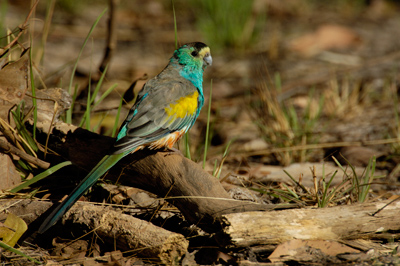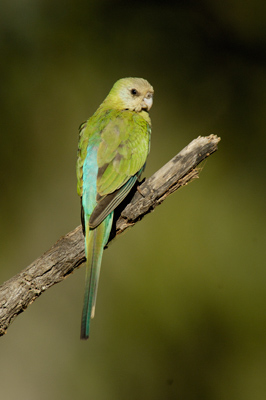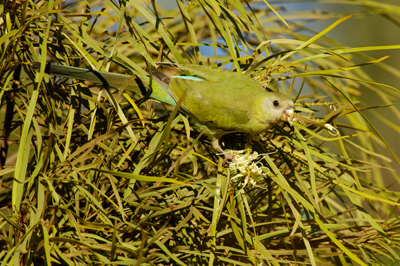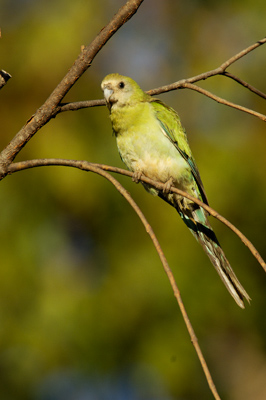Artemis Station is a working cattle station in the central southern portion of the peninsula. The station covers a significant portion of land, including the core range of the highly endangered and endemic Golden-shouldered Parrot. This beautiful parrot is only found in a small area in the southern portion of the Cape York Pen insula where it nests in the large ant hills that dot the landscape. For birders to see these birds, the only real chance is one of two ways. First, if it is in the breeding season, the owner of Artemis Station, Sue Shepherd, often will take visiting birders out to see the birds. Or, if the breeding season is over and it is late in the Dry, the birds are often seen coming in to drink at permanent water sources, the most famous of which is a small farm dam along Windmill Creek. I was going to be visiting at the tail end of the breeding season and the birds probably had dispersed from their regular nesting area. Knowing this and not wanting to take Sue away from her busy life running a cattle station (they were mustering while I was there), I decided to try to stake out the birds at the dam on Windmill Creek.
insula where it nests in the large ant hills that dot the landscape. For birders to see these birds, the only real chance is one of two ways. First, if it is in the breeding season, the owner of Artemis Station, Sue Shepherd, often will take visiting birders out to see the birds. Or, if the breeding season is over and it is late in the Dry, the birds are often seen coming in to drink at permanent water sources, the most famous of which is a small farm dam along Windmill Creek. I was going to be visiting at the tail end of the breeding season and the birds probably had dispersed from their regular nesting area. Knowing this and not wanting to take Sue away from her busy life running a cattle station (they were mustering while I was there), I decided to try to stake out the birds at the dam on Windmill Creek.
I arrived in the area on September 14th and planned to spend two nights, leaving midmorning on the 16th to continue north. This would give me two mornings and two evenings to sit and watch for the birds, hopefully adequate time to see them. However, it turns out that despite spending over 12 hours sitting next to the small pond over 3 days, the birds never came in to drink. During my time there I  saw a wide range of other birds including my first Red-tailed Black-Cockatoos and numerous honeyeaters coming in to bathe, but no Golden-shouldered Parrots. I think that since there was an unusually wet and late Wet Season this past year, there is still a lot of water in the area and the birds are likely drinking at other water holes, not confined to the ones on Windmill Creek.
saw a wide range of other birds including my first Red-tailed Black-Cockatoos and numerous honeyeaters coming in to bathe, but no Golden-shouldered Parrots. I think that since there was an unusually wet and late Wet Season this past year, there is still a lot of water in the area and the birds are likely drinking at other water holes, not confined to the ones on Windmill Creek.
Disappointed, I moved on but returned on September 24, 2006 on my way back south. This time I was armed with additional information of a recent sighting, just about 500km south of Windmill Creek on the opposite side of the road. I arrived late in the afternoon and decided to go for a short walk to see what I could see. After a brief walk east, I hadn’t seen anything out of the ordinary so decided to head back to the car and set up camp. On my way back, I heard a flock of birds flying low over the trees but with a bit different call note than I was used to hearing from Rainbow Lorikeets. They were flying low and fairly fast and I never got my binoculars on them, but I was able to see that they were of a species that I had not yet seen. The birds were fairly light, green, and had very long tails, all good signs. A few minutes later another flock flew over, this time only with about five birds and while I still couldn’t get my binoculars on them, I was able to confirm they were the same species as the previous flock.
After they had passed, I could still hear the unfamiliar call note that had alerted me to the first flock. After a few minutes of searching, I discovered the source, three Golden-shouldered Parrots sitting in the top of a tree just a short way away. Finally, one of my most desired birds, sitting in front of me. After a few minutes and excellent views of two males and a single female, I headed back to the car since it was getting late. I had seen my bird, and quite conveniently, it was my 300th species for my year.
The next morning, I got up at dawn and as I was  setting up my camera, I began to hear that once unfamiliar call note of the Golden-shouldereds. Within just a few seconds I was able to locate a flock of birds, probably a dozen or so, at the top of a tree fairly close by my car. Over the next few hours, I managed to photograph these beautiful birds to my heart’s content. At one point, I counted 25 birds feeding on the ground in front of me, five of which were males. I was able to photograph both males and females in trees and on the ground. I did not get to photograph them on the ant or termite mounds where they nest since the breeding season was over, but regardless, I was thrilled with the images I did get.
setting up my camera, I began to hear that once unfamiliar call note of the Golden-shouldereds. Within just a few seconds I was able to locate a flock of birds, probably a dozen or so, at the top of a tree fairly close by my car. Over the next few hours, I managed to photograph these beautiful birds to my heart’s content. At one point, I counted 25 birds feeding on the ground in front of me, five of which were males. I was able to photograph both males and females in trees and on the ground. I did not get to photograph them on the ant or termite mounds where they nest since the breeding season was over, but regardless, I was thrilled with the images I did get.
As I mentioned, the Golden-shouldered Parrot nests in large ant or termite mounds that are found across the drier parts of the Cape. Because of this, they are confined to a relatively small area of land and are quite vulnerable to predators and human disturbances. They are listed as endangered and estimates place the population at somewhere between 500 and 1,000 birds including about 150 breeding pairs.
In the last few years, controlled burns have been instated to help control the vegetation around the termite mounds which, without fire, grows and provides cover for nest predators such as Pied or Black-backed Butcherbirds. The goal of these new fire regimes is to reduce the cover for predators, thereby the nest predation, hopefully helping to boost the survival of the Golden-shouldered Parrots.
Ever since I learned about these birds when I first started planning my year in Australia, they have really grabbed me. They were one of the top birds I wanted to see and photograph during my travels this year, yet at the same time I had serious doubts if I would be able to see them at all, much less photograph them. I was very fortunate to see these birds and having the opportunity to photograph these gorgeous birds was quite amazing. Someday, I hope to return to the area to do a full photographic study of these birds as well as the closely related parrot found south of Darwin, the Hooded Parrot.
